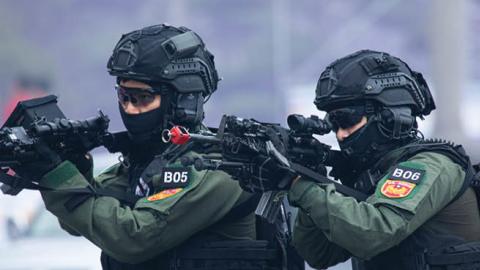The confirmation on 7 October that U.S. Special Operations Forces have been training the Taiwanese military since last year is a welcome sign of policy continuity between otherwise non-contiguous administrations.
Mr. Biden's China policy has been diffuse at best. Despite accusing Mr. Trump of conducting incoherent foreign policy, the Biden team often acts on contradictory lines of effort. Biden's Secretary of State Antony Blinken held a three-day summit in Anchorage in March 2021, which devolved into diplomatic grandstanding. Mr. Blinken presented a list of concerns from the U.S. and its allies to which China's de facto foreign policy architect, Politburo member Yang Jiechi, responded acrimoniously. After accounting for inflation, Mr. Biden's proposed defense budget would have reduced spending in real terms, forcing the armed services, most notably the Navy, to choose between combat readiness and future procurement.
The Biden administration has functionally abandoned its promised investigation into COVID-19's origins and refused to mention China's role in the pandemic, Chinese genocide in Xinjiang, or its coup in Hong Kong during his UN General Assembly address. John Kerry was resurrected from political irrelevance, and now Biden's "Climate Czar," maintained in April that combating the specter of climate change outweighed any other consideration vis-a-vis China. Mr. Biden, alongside British Prime Minister Boris Johnson and Australian Prime Minister Malcolm Turnbull, orchestrated the AUKUS pact, which alienated France and will not provide Australia with viable submarine capabilities for a minimum of twenty years then denied its relevance to U.S.-China rivalry. In the aftermath of China's 150-aircraft airspace incursions into Taiwan between 1 and 4 October, Biden referred to a non-existent "Taiwan Agreement" that supposedly would guide Sino-American relations. Unlike a more skilled political leader – for example, British Liberal Prime Minister HH Asquith – Mr. Biden shows neither the desire nor competence to integrate the spending demands of his base with the political-military requirements of deterring China.
The trend is clear: each beneficial action is concurrent with either undermining resolve or creating additional negative consequences.
The announcement of U.S. presence in Taiwan will not have a transformative military effect. It appears that only around two dozen Marine “Raiders” – the Marine Corps’ term for its Special Operations Forces – are on the island, an amount too small to serve even as a “tripwire” to deter escalation.
It is, however, an important symbol, much like U.S. Ambassador to Palau John Hennessey-Niland’s visit to Taiwan in late March 2021. No U.S. military presence in Taiwan has been acknowledged publicly since 3 May 1979, when the U.S. stood down its U.S.-Taiwan Defense Command and recognized the Beijing regime as China's legitimate government. This symbol's importance lies not in its existence but in its admission. U.S. forces have been sighted in Taiwan in the past, in June and November 2020 during the Trump administration. But in each case, the Executive Branch did not publicly acknowledge their existence – in the clearest case, and only the U.S. Army released a video of Green Berets on the island. Moreover, Chinese intelligence is capable enough to have identified these forces months ago. The difference, in this case, is the mode of transmission, a statement by "anonymous defense officials," which implies a planned leak from the Biden administration but not a formal public admission.
Foreign policy relies on this sort of communication. Great-power politics is, at risk of understatement, difficult. Political decision-making is opaque, particularly with an authoritarian oligarchy like China, and must consist of subtle nods and intentional omissions more often than formal statements. Interpreting this signal raises two implications about the Biden administration’s China policy.
First, despite its lack of focus and coordination, there is at minimum an element within the Biden administration that regards Taiwan as worthy of direct military support. This support remains halting and half-hearted, but it clearly exists. Moreover, a limited military presence allows the U.S. to support a Taiwanese diplomatic push for greater international recognition. Even a small SOF contingent can become the nucleus of a new U.S. Taiwan Defense Command with a de jure independent Taiwan's legal support. China certainly understands this signal. It likely will continue its pressure on the island republic, escalating its rhetoric and threatening the U.S. and Japan to prevent their greater recognition of Taiwan. But Japanese political figures have made multiple public statements that they would view a Chinese attack on Taiwan as a “mortal threat” to Japan’s sovereignty, most notably from then-Deputy Prime Minister Taro Aso, who was subsequently moved to his current position as Liberal Democratic Party Vice President. And while Japan has refrained from commenting on the AUKUS pact, it remains a public member of the "Quad," the political-agreement-cum-informal-alliance that will form the core of an anti-Chinese coalition far more effectively than AUKUS. Thus, an integrated U.S.-Japanese diplomatic approach is clearly possible, which the U.S. SOF deployment facilitates.
Second, the U.S. SOF detachment’s military role provides a hint about U.S.-Taiwanese strategic thinking. Once again, the SOF deployment is neither a credible deterrent nor a tripwire. Yet, any military deployment carries with it an explicit strategic purpose. In this case, the nature of the force offers a clue when placed alongside previous unconfirmed deployments to Taiwan. All SOF are cross-trained in multiple mission sets, ranging from direct action to Foreign Internal Defense, the U.S. military’s term for counterinsurgency. But a force of two dozen Marine Raiders has a more specific mission than simple training – this deployment is at most one platoon, and perhaps simply multiple squads with a staff sergeant. Moreover, a SOF unit, the U.S. Army’s 1st Special Forces Group, is already subordinate to U.S. Indo-Pacific Command and traditionally is used for these sorts of missions, rather than Marine Raiders. Additionally, given their role as specialized light infantry, it is less likely that these SOF will be used to train Taiwanese tank, armored vehicles, or anti-aircraft crews.
Thus, it is likely that this platoon of Marine SOF is training the Taiwanese both in conventional tactics and guerrilla warfare methods. Indeed, this was the initial purpose of American SOF. Although SOF are best-known for their activities in the Vietnam War, these units were “stood up” to train NATO allies in guerrilla tactics and, in the event of a Warsaw Pact offensive, conduct an unconventional campaign in Soviet-occupied territory to facilitate a NATO counteroffensive.
Most public discussion over Taiwan’s defense emphasizes the island republic's challenge in defeating a Chinese invasion, absent American and allied support. This is the critical quandary that bedevils American planners. China's missile arsenal effectively pushes American carriers around 400-500 miles away from the Chinese coastline to remain secure from shorter-range, more numerous anti-ship cruise missiles. The current Carrier Air Wing lacks the missiles, long-range strike aircraft, and range extenders to conduct effective strikes at this range. Thus, the U.S. and its allies will rely on a limited number of stand-off munitions and submarines to contest a Chinese invasion of Taiwan.
Scant discussion considers whether an effective insurgency on Taiwan would facilitate American and allied goals. In one sense, it clearly would. By diverting resources and attention from a likely fleet action in the Philippine Sea or a breakout into the Indian Ocean, a Taiwanese insurgency would quickly complicate China's attempts to end a Pacific war. Moreover, mobile anti-air and anti-ship missiles working in concert with guerrilla light infantry operating in Taiwan's mountainous interior would consistently threaten Chinese ships and aircraft transiting the Miyako Strait or Bashi Channel into the Philippine Sea. Insufficient numbers of forward-deployed American and allied naval forces alongside the long time required to move forces to the region suggest that preparing an insurgency may be a prudent complement to conventional force in defending Taiwan. More broadly, the U.S. must consider establishing, initially in secret then openly, a multinational command center – in U.S. military parlance a Joint Combined Operations Center – that coordinates planning and training between Taiwanese, Japanese, American, and perhaps Australian, British, and South Korean forces, depending upon diplomatic circumstances. This step would prove a coherence to Mr. Biden’s China policy that is currently lacking.
This policy, however, hinges upon a more central question. An insurgency requires time. It is an attritive strategy intended to probe an enemy and slowly accumulate power until a catalytic moment arrives, in this case, an American and allied counterattack. This effort must last for more than days or weeks. Supporting an insurgency as a matter of policy implies that the U.S. has committed to a multi-month or even multi-year war with China, which far prefers a lightning strike followed by victory. Effective U.S. deterrence should aim to prevent this.
Read in RealClear Defense

















